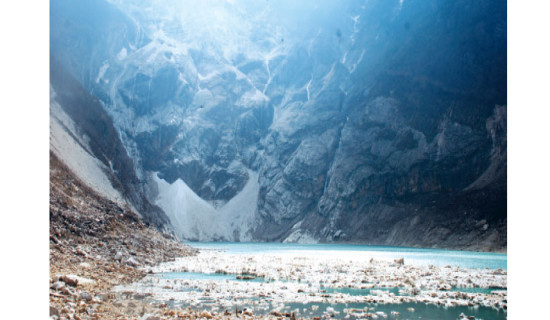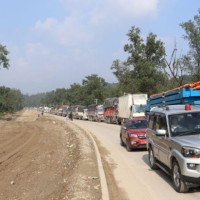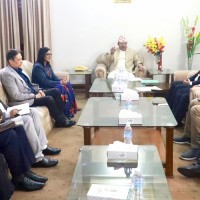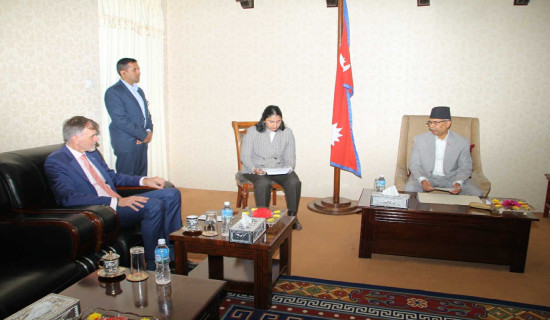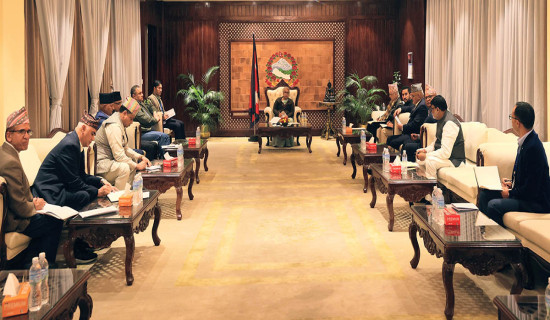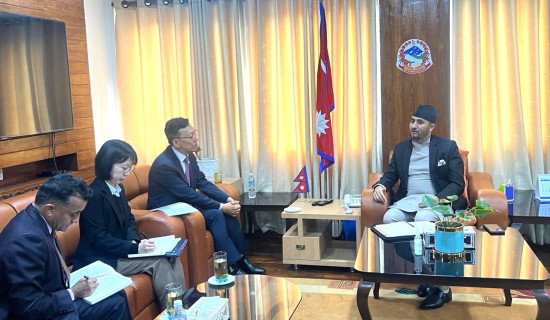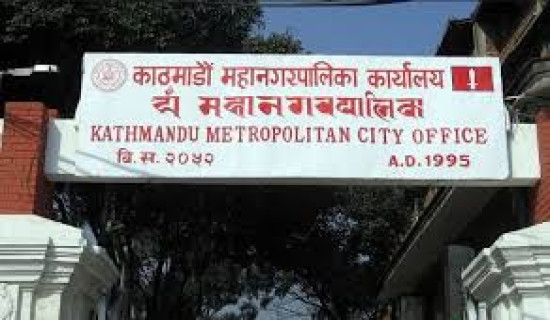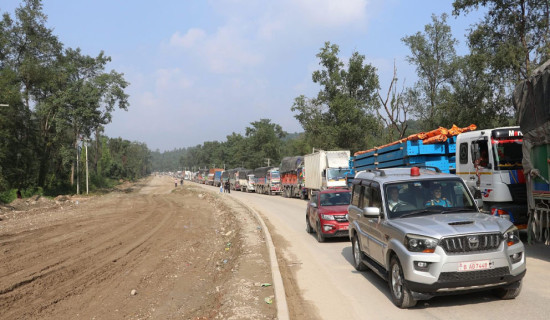- Monday, 3 November 2025
Strategies For Economic Stability
RASTRA DHOJ KARKI
Nepal, a small landlocked country in South Asia, is currently grappling with economic challenges. The Gross Domestic Product (GDP) of Nepal is in a precarious position, with both possibilities and difficulties before it. The 2015 earthquakes and the COVID-19 outbreak have revealed the vulnerability of Nepal's economy to external shocks, causing significant devastation. These crises have thrown off the country's economic trajectory and daily life, highlighting the essential need for resilience and adaptation against adversity.
The inefficient expenditure also arises from the current provincial structure, wherein multiple provinces maintain separate teams of ministers and government employees solely tasked with mediating between local and central governments—a design widely regarded as redundant and akin to the proverbial advice, "Do not keep an elephant as a pet if you cannot afford to feed it." Considering the current financial constraints of the nation, it is imperative to eliminate or suspend these expenditures until the country's GDP experiences significant improvement, as the current fiscal burden has become increasingly unsustainable. In times of need, Nepal received aid from countries such as the US, UK, India, China, Japan, and more, highlighting the importance of international cooperation. The nation should reduce its dependency by encouraging self-reliance, decreasing reliance on loans, and raising revenue streams to advance its economic prospects sustainably.
Moreover, Nepal has faced resource constraints, limited financial resources, and technological capabilities that have made it problematic to fund and execute large-scale infrastructure projects, slowing down progress in improving transportation networks and other vital facilities needed for economic growth. Additionally, political corruption and bureaucracy have often led to inefficiencies and delays in project implementation, such as strikes (Nepal Banda) and closing work. Instead of causing a racket that affects the livelihood of civilians, the affected people should discuss these issues with the concerned department. These problems have discouraged private sector involvement and foreign investments.
To transform Nepal into a self-sufficient country and boost its GDP, a comprehensive master plan is crucial. Firstly, investing in infrastructure, accessibility, and marketing to improve tourism is essential. Developing educational institutions to create a regional education hub can attract students abroad and generate revenue. Integrating IT education from grade 5 onward will produce a tech-savvy workforce. Leveraging Nepal's abundant water resources for hydroelectricity projects can meet domestic needs and export surplus power to neighbouring countries. Promoting industrial growth through factories and focusing on niche markets like Ayurvedic medicine, agricultural products, and freshwater exports will diversify the economy. Exploring and responsibly mining minerals like uranium can add to the revenue stream. Additionally, enabling entrepreneurship, simplifying regulations, and improving the ease of doing business will encourage private-sector participation. Finally, efficient governance, anti-corruption measures, and regional collaboration will be critical to realising this ambitious master plan.
Now let us investigate some countries that have developed astonishingly. Switzerland and Nepal share similar geographic traits but have developed their infrastructure and GDP differently. Let's talk about Switzerland, a small nation that has made infrastructural improvements such as a comprehensive network of roads, trains, and airports. Accessibility drew customers, travellers, and assets, which boosted the GDP. Switzerland also prioritised education, producing a knowledgeable workforce capable of fostering innovation and supporting a robust financial industry.
Shifting to another country, Singapore recognised early on that efficient infrastructure was essential for economic growth. The government invested heavily in building and maintaining world-class infrastructure. The Port of Singapore, one of the busiest in the world, was expanded and modernised, solidifying its position as a global trade hub. The city-state also invested in a comprehensive transportation network, including an extensive metro system and well-maintained roads, ensuring seamless connectivity for businesses and residents. Singapore focused on creating a business-friendly environment. The development of industrial parks, like Jurong Industrial Estate, attracted multinational corporations and encouraged foreign investments. These efforts led to the growth of manufacturing and the establishment of a thriving financial sector.
And Dubai, a tale of a small town that became a major economic powerhouse, The authorities in Dubai understood the value of modern infrastructure. They invested in infrastructure such as ports, motorways, and airports. Dubai International Airport, which links the city to international markets, is now among the busiest in the world, and the Port of Dubai is a significant centre for global commerce. Dubai built famous landmarks like the Burj Khalifa and the Palm Jumeirah for tourism, which have drawn millions of tourists. For residents and visitors, the Dubai Metro ensures adequate mobility. Dubai is also renowned for its duty-free and tax-free shopping scene, making Dubai a haven for fashionable shoppers and tourists seeking exceptional deals. Dubai's economy was historically reliant on oil, but its leaders knew the importance of diversification. They expanded into various sectors, such as finance, trade, tourism, and real estate. The Dubai International Financial Centre (DIFC) and Dubai's status as a free trade zone have attracted multinational companies.
Conversely, Nepal, while blessed with natural beauty, faced challenges in infrastructure development due to rugged terrain and limited resources. The country struggled with political instability, which hindered long-term planning and investments. As a result, Nepal's infrastructure remained underdeveloped, making it less attractive for businesses and tourists. This lack of infrastructure and economic instability hindered GDP growth.
A prominent way to increase GDP is for Nepal to act as a transit point between China and India. Its prospect as a transit point between India and China can mutually benefit all three countries. If the trade is well managed, it can generate revenue through transit fees, customs duties, and trade-related services while improving international relationships. Developing and upgrading transportation infrastructure (roads, railways, and border crossings) is crucial to ensuring efficient transit and attracting businesses looking for shorter trade routes. Investment in infrastructure may require cooperation and investment from India and China. Nepal has significant untapped hydroelectric potential. Selling electricity to energy-hungry markets like India and China can generate revenue, boost Nepal's economy, and provide clean energy to its neighbours and itself. To harness this potential, Nepal may need foreign investment and expertise. India and China could recognise the value of such cooperation and invest in hydroelectric projects or participate in joint ventures. However, it's important to note that these opportunities also come with challenges. Political collaboration and stability are critical, as are fair trade agreements and sustainable practices for hydroelectric projects. Additionally, the priorities and interests of the involved countries may evolve, impacting the feasibility and pace of such initiatives.
In September 2023, during the G20 summit held in India, Prime Minister Narendra Modi eloquently stated, "The world is one family," drawing inspiration from a Sanskrit scripture that underscores the importance of global unity and universal peace. The G20 should also consider extending invitations to the neighbouring countries of the host nation as special guests for its annual meetings. This inclusive approach would foster regional cooperation and allow neighbouring nations to voice their concerns and perspectives on global issues. To draw inspiration, we've looked at countries like Switzerland, Singapore, and Dubai, which strategically invested in infrastructure, education, and business-friendly environments. These nations transformed their economic landscapes and became global leaders. Nepal's potential as a transit point between India and China and its untapped hydroelectric resources could be game changers, but this requires political stability and the agreement of all three nations. All leaders of their political parties should commit to a better Nepal in their sectors.
(Karki persue higher study in computer software.)



